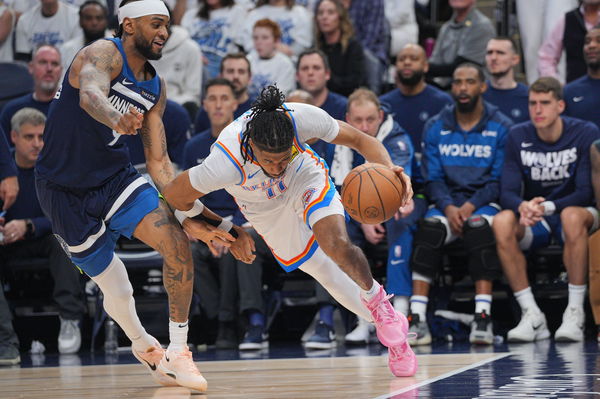

Chris Finch just served up the ultimate defensive blueprint for shutting down Shai Gilgeous-Alexander, and yeah, the 42-point beatdown the Wolves delivered says it all. This wasn’t your average lockdown defense — it was aggressive, physical, and smartest of all, clean. No foul trouble handed over like freebies, which is usually the secret sauce Shai cooks with. But Minnesota kept their hands to themselves, forcing Shai into tough shots and totally killing his rhythm. That’s the kind of defense you don’t see every day.
Watch What’s Trending Now!
The Wolves showed what it takes to contain a star like SGA — length, discipline, energy, and coaching that demands precision. Shai went from dropping 31 points and getting to the line 10 times in Game 1, to just 14 points and 4 free throws in Game 3. that’s a well-oiled defensive machine clicking on all cylinders. Jaden McDaniels, Anthony Edwards, and Nickeil Alexander-Walker were all over him, using their length to contest everything without biting on his usual foul-drawing tricks. And of course, Rudy Gobert patrolling the paint made sure no easy buckets slipped through.
As Chris Finch put it, “We just were more aggressive everywhere. I thought we were a little cleaner around him—we didn’t foul. Our competitiveness was at an all-time high.” Shai is a phenomenal player, but the Wolves made sure he didn’t have many nights like this one.
ADVERTISEMENT
Digging into why this worked so well, it goes deeper than just physical tools. The Wolves didn’t just play aggressive defense—they played smart aggressive defense. No lazy fouls. No wild gambles. Just sharp rotations and nonstop pressure. Shai averages nearly nine free throws a night; Minnesota cut that in half. That’s not just impressive—that’s disruptive.

Imago
May 24, 2025; Minneapolis, Minnesota, USA; Oklahoma City Thunder guard Isaiah Joe (11) dribbles the ball past Minnesota Timberwolves guard Nickeil Alexander-Walker (9) during the first half in game three of the western conference finals for the 2025 NBA Playoffs at Target Center. Mandatory Credit: Brad Rempel-Imagn Images
When you take away the line from a guy like Shai Gilgeous-Alexander, you’re pulling the foundation out from under his game. He has to settle for tough pull-ups or weave through layers of defenders, and suddenly, the rhythm’s gone. But here’s the thing: pulling that off takes more than talent. It takes discipline, relentless communication, and the kind of team-wide focus that doesn’t blink for 48 minutes. And above all, it takes a coach who lives and breathes that system until it’s second nature.
ADVERTISEMENT
So yes, Finch cracked a code. But let’s be real—this isn’t a plug-and-play setup any team can copy overnight. It’s not enough to want it. You need length, athleticism, sky-high defensive IQ, and a backline rim protector who erases mistakes like a hard reset. And when you look around the East?
Sure, a few teams look close. But only one actually feels ready to run this blueprint without it falling apart.
ADVERTISEMENT
So who’s close? And who’s kidding themselves? Let’s break it down.
Why This Blueprint Will Only Help One Eastern Conference Coach—and Which Teams Come Close
Let’s be honest—Shai Gilgeous-Alexander didn’t just struggle against Minnesota. He got hunted. The Timberwolves didn’t send the kitchen sink. They sent the whole damn plumbing system. Jaden McDaniels tracked him like a grudge. Rudy Gobert turned the paint into a no-fly zone. Every help defender showed up on cue like Broadway performers hitting their marks. That wasn’t just defense—it was a masterclass in lockdown.
ADVERTISEMENT
Now, compare that to the East. If OKC makes the Finals, who’s actually ready to replicate that blueprint?
Take Indiana. On paper, they look the part: Pascal Siakam’s length, Aaron Nesmith’s motor, Mathurin’s bounce, Nembhard’s pesky hands, and Haliburton’s speed. Their transition defense boasts a respectable 113.8 defensive rating. Sounds promising, right? But look closer. Myles Turner’s drop coverage is a sieve, giving opponents a green light at the rim. When he’s off the floor, teams shoot 56.1% at the rim. And the foul trouble? They hand out freebies 22.7 times per game. So while Indiana has the tools, their defense lacks the stability and discipline Minnesota showed.
Now, flip the script to the Knicks. Under Thibs, every night feels like Game 7. They don’t just play defense—they embody it. OG Anunoby, Mikal Bridges, and Josh Hart form a perimeter triangle of doom. Mitchell Robinson’s rim protection is gospel, with Hartenstein playing the backup bouncer role. Their pace is grinding, slow, and methodical, and their offense sits at a solid 112.6 rating, dragging opponents into a physical, exhausting slog.
ADVERTISEMENT
Sure, the Knicks have their flaws. Their bench leaks points—113.0 defensive rating when starters rest—and Brunson’s heavy usage wears him down late. But the identity is clear: discipline, detail, full buy-in, and stamina like a hostage drill. Unlike Indiana’s shaky IKEA setup, the Knicks are a finely tuned East Coast remix of Minnesota’s defensive blueprint.
So yeah, Finch handed out the ultimate cheat code for Shai Gilgeous-Alexander and the OKC. But just like any open-book test, success depends on preparation. Some teams pretend, some cheat, but only a few really study like their season depends on it. The blueprint is out. How teams use it? That’s the drama we’re watching unfold.
ADVERTISEMENT
ADVERTISEMENT
ADVERTISEMENT

